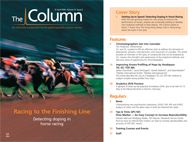Characterizing New Psychoactive Substances
Researchers from the Joint Research Centre of the European Commission have published a case study detailing the characterization of new psychoactive substances using gas chromatography–mass spectrometry, nuclear magnetic resonance, high‑resolution tandem mass-spectrometry, and Raman spectroscopy.
Photo Credit: Rafe Swan/Getty Images

Researchers from the Joint Research Centre (JRC) of the European Commission have published a case study detailing the characterization of new psychoactive substances (NPSs) using gas chromatography–mass spectrometry (GC–MS), 1H and 13C nuclear magnetic resonance (NMR), highâresolution tandem mass-spectrometry (HR–MS–MS), and Raman spectroscopy.1
New psychoactive substances are an increasing concern across Europe because of their potential health risks. Derived from existing substances, NPSs have a slight alteration in their chemical structure, enough to avoid current laws and regulations while maintaining pharmacological activity. For this reason they are often marketed as “legal highs”, “natural herbal products”, “food supplements”, or “research chemicals” and can therefore be legally sold on the market.2
In the last five years the rate of NPS production has increased dramatically and during 2014 a total of 101 new substances were reported for the first time to the EU Early Warning System.2 Seizure data from law enforcement adds further evidence to the growth of this drug market because between 2008 and 2013 a sevenfold increase in the number of seizures was reported across Europe.2
“Analytical chemists usually rely on preâexisting information about the chemical structure of a substance or on standard chemical materials to compare an unknown substance with. These do not exist for most of the new substances,” explained Joana Lobo Vicente from the JRC laboratory in Ispra, Italy.
Developing detection methods for these substances represents a significant challenge for analytical chemists. Fully characterizing a substance “requires an advanced set of sophisticated analytical instrumentation and chemo-informatics tools,” continued Lobo Vicente. “[This is] a platform we have at the JRC. Once we have understood the chemical structure of a NPS, analysts in other laboratories will be able to detect and monitor it.”
The case study focused on a parcel apprehended by Belgian customs authorities that originated from China and contained two samples, declared as “white pigments”. The substances were initially analyzed by Belgian Customs Laboratories using GC–MS and Fourierâtransform infrared spectroscopy before full characterization using 1H and 13C NMR, HR–MS–MS, and Raman spectroscopy by the JRC.
Through this methodology the substances were identified as synthetic cannabinoids 5F-AMB and PX-3. Synthetic cannabinoids mimic the effects of cannabis in the endocannabinoid system but are more toxic than cannabis.3 The result differs from the intended purchase because the purchaser believed the package to contain one synthetic cannabinoid and one benzodiazepine. Benzodiazepines are often taken in combination with other drugs to heighten the effects or to counterbalance the adverse effects of other drugs.4
“NPSs constitute a serious public health threat. In the past years different Member States [of the EU] have reported several cases of serious intoxications and even fatalities,” said Lobo Vicente. This particular case study highlights the issues with on-line retailers who sell NPSs, because the contents of the products are not necessarily what they are advertised as.
“Currently our work focuses on identifying as quickly as possible the chemical structure of the new psychoactive substance appearing on the market and on establishing their chemical ‘fingerprint’ and chemoinformatic identifiers, allowing other laboratories to clearly recognize them and monitor their diffusion on the market,” stated Lobo Vicente. The “fingerprints” produced by the JRC laboratory are available in a public library and are used by control laboratories. In the future, it is expected hospitals will also be able to use this information to detect NPS.
Despite the increasing challenge it is hoped that through this method, chemists and regulatory agencies will be better equipped to react to NPSs in a much swifter fashion and combat potentially lethal drugs being sold across Europe. - L.B.
References
- J. Lobo Vicente et al.,Forensic Sci. Int.265, 107–115 (2016).
- EMCDDA, European Drug Report - Trends and Development (2015).
- U. Bonnet and H. Mahler, Fortschr. Neurol. Psychiatr.83(4), 221–231(2015).
- C.P. O’Brien, J. Clin. Psychiatry66(2), 28–33 (2005).

Distinguishing Alcohol- from Non-Alcohol-Associated Liver Cirrhosis with LC-MS
May 7th 2025A pilot study investigating whether nicotinamide adenine dinucleotide kinase (NADK) expression is selectively diminished in alcohol-associated liver cirrhosis (AC), as well as evaluating its potential as a biomarker for this condition, measured AC and non-AC (NAC). Nicotinamide adenine dinucleotide (NAD+) and nicotinamide adenine dinucleotide phosphate (NADP+) levels in human liver samples were measured using liquid chromatography-mass spectrometry (LC-MS).

.png&w=3840&q=75)

.png&w=3840&q=75)



.png&w=3840&q=75)



.png&w=3840&q=75)










